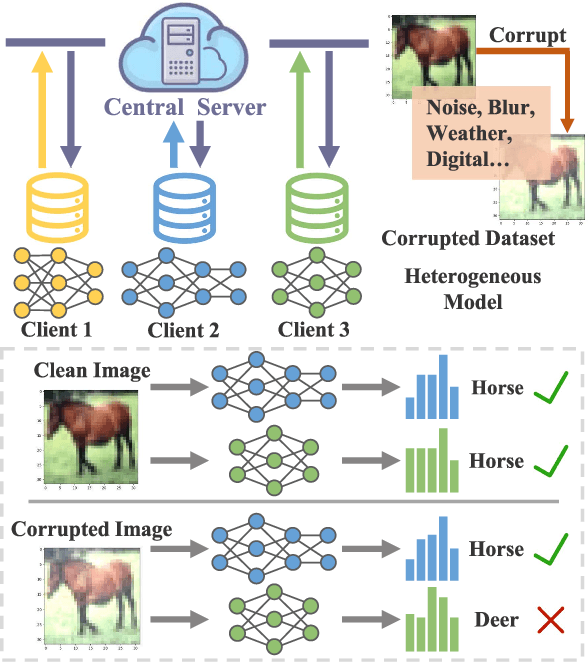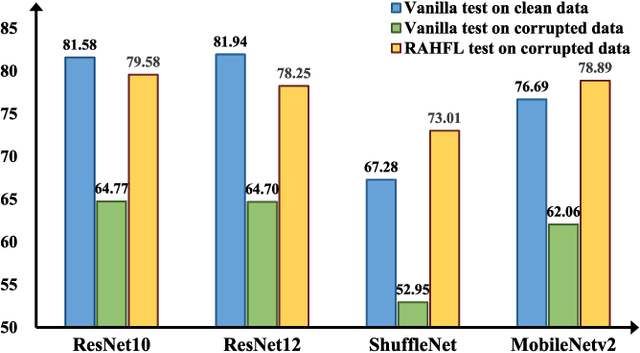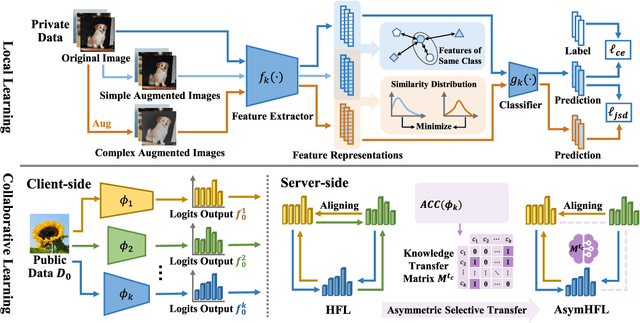Mang Ye
Wuhan University
S2FGL: Spatial Spectral Federated Graph Learning
Jul 03, 2025Abstract:Federated Graph Learning (FGL) combines the privacy-preserving capabilities of federated learning (FL) with the strong graph modeling capability of Graph Neural Networks (GNNs). Current research addresses subgraph-FL only from the structural perspective, neglecting the propagation of graph signals on spatial and spectral domains of the structure. From a spatial perspective, subgraph-FL introduces edge disconnections between clients, leading to disruptions in label signals and a degradation in the class knowledge of the global GNN. From a spectral perspective, spectral heterogeneity causes inconsistencies in signal frequencies across subgraphs, which makes local GNNs overfit the local signal propagation schemes. As a result, spectral client drifts occur, undermining global generalizability. To tackle the challenges, we propose a global knowledge repository to mitigate label signal disruption and a frequency alignment to address spectral client drifts. The combination of spatial and spectral strategies forms our framework S2FGL. Extensive experiments on multiple datasets demonstrate the superiority of S2FGL. The code is available at https://github.com/Wonder7racer/S2FGL.git.
A Retrieval-Augmented Multi-Agent Framework for Psychiatry Diagnosis
Jun 04, 2025Abstract:The application of AI in psychiatric diagnosis faces significant challenges, including the subjective nature of mental health assessments, symptom overlap across disorders, and privacy constraints limiting data availability. To address these issues, we present MoodAngels, the first specialized multi-agent framework for mood disorder diagnosis. Our approach combines granular-scale analysis of clinical assessments with a structured verification process, enabling more accurate interpretation of complex psychiatric data. Complementing this framework, we introduce MoodSyn, an open-source dataset of 1,173 synthetic psychiatric cases that preserves clinical validity while ensuring patient privacy. Experimental results demonstrate that MoodAngels outperforms conventional methods, with our baseline agent achieving 12.3% higher accuracy than GPT-4o on real-world cases, and our full multi-agent system delivering further improvements. Evaluation in the MoodSyn dataset demonstrates exceptional fidelity, accurately reproducing both the core statistical patterns and complex relationships present in the original data while maintaining strong utility for machine learning applications. Together, these contributions provide both an advanced diagnostic tool and a critical research resource for computational psychiatry, bridging important gaps in AI-assisted mental health assessment.
An Empirical Study of Federated Prompt Learning for Vision Language Model
May 29, 2025Abstract:The Vision Language Model (VLM) excels in aligning vision and language representations, and prompt learning has emerged as a key technique for adapting such models to downstream tasks. However, the application of prompt learning with VLM in federated learning (\fl{}) scenarios remains underexplored. This paper systematically investigates the behavioral differences between language prompt learning (LPT) and vision prompt learning (VPT) under data heterogeneity challenges, including label skew and domain shift. We conduct extensive experiments to evaluate the impact of various \fl{} and prompt configurations, such as client scale, aggregation strategies, and prompt length, to assess the robustness of Federated Prompt Learning (FPL). Furthermore, we explore strategies for enhancing prompt learning in complex scenarios where label skew and domain shift coexist, including leveraging both prompt types when computational resources allow. Our findings offer practical insights into optimizing prompt learning in federated settings, contributing to the broader deployment of VLMs in privacy-preserving environments.
ThanoRA: Task Heterogeneity-Aware Multi-Task Low-Rank Adaptation
May 24, 2025Abstract:Low-Rank Adaptation (LoRA) is widely adopted for downstream fine-tuning of foundation models due to its efficiency and zero additional inference cost. Many real-world applications require foundation models to specialize in multiple tasks simultaneously, motivating the need for efficient multi-task adaptation. While recent approaches integrate LoRA with mixture-of-experts (MoE) to address this, the use of routers prevents parameter mergeability, which increases inference overhead and hinders unified multi-task adaptation, thereby limiting deployment practicality. In this work, we propose ThanoRA, a Task Heterogeneity-Aware Multi-Task Low-Rank Adaptation framework that enables multi-task adaptation while preserving the inference efficiency of LoRA. ThanoRA jointly models task heterogeneity and mitigates subspace interference throughout training. Specifically, motivated by inherent differences in complexity and heterogeneity across tasks, ThanoRA constructs task-specific LoRA subspaces at initialization, enabling fine-grained knowledge injection aligned with task heterogeneity. Furthermore, to prevent task interference and subspace collapse during multi-task training, ThanoRA introduces a subspace-preserving regularization that maintains the independence of task-specific representations. With the synergy of both components, ThanoRA enables efficient and unified multi-task adaptation. Extensive experiments across multimodal and text-only benchmarks under varying multi-task mixtures demonstrate that ThanoRA consistently achieves robust and superior performance over strong baselines without introducing additional inference overhead. Our code is publicly available at: https://github.com/LiangJian24/ThanoRA.
Backdoor Cleaning without External Guidance in MLLM Fine-tuning
May 22, 2025Abstract:Multimodal Large Language Models (MLLMs) are increasingly deployed in fine-tuning-as-a-service (FTaaS) settings, where user-submitted datasets adapt general-purpose models to downstream tasks. This flexibility, however, introduces serious security risks, as malicious fine-tuning can implant backdoors into MLLMs with minimal effort. In this paper, we observe that backdoor triggers systematically disrupt cross-modal processing by causing abnormal attention concentration on non-semantic regions--a phenomenon we term attention collapse. Based on this insight, we propose Believe Your Eyes (BYE), a data filtering framework that leverages attention entropy patterns as self-supervised signals to identify and filter backdoor samples. BYE operates via a three-stage pipeline: (1) extracting attention maps using the fine-tuned model, (2) computing entropy scores and profiling sensitive layers via bimodal separation, and (3) performing unsupervised clustering to remove suspicious samples. Unlike prior defenses, BYE equires no clean supervision, auxiliary labels, or model modifications. Extensive experiments across various datasets, models, and diverse trigger types validate BYE's effectiveness: it achieves near-zero attack success rates while maintaining clean-task performance, offering a robust and generalizable solution against backdoor threats in MLLMs.
CoT-Kinetics: A Theoretical Modeling Assessing LRM Reasoning Process
May 19, 2025Abstract:Recent Large Reasoning Models significantly improve the reasoning ability of Large Language Models by learning to reason, exhibiting the promising performance in solving complex tasks. LRMs solve tasks that require complex reasoning by explicitly generating reasoning trajectories together with answers. Nevertheless, judging the quality of such an output answer is not easy because only considering the correctness of the answer is not enough and the soundness of the reasoning trajectory part matters as well. Logically, if the soundness of the reasoning part is poor, even if the answer is correct, the confidence of the derived answer should be low. Existing methods did consider jointly assessing the overall output answer by taking into account the reasoning part, however, their capability is still not satisfactory as the causal relationship of the reasoning to the concluded answer cannot properly reflected. In this paper, inspired by classical mechanics, we present a novel approach towards establishing a CoT-Kinetics energy equation. Specifically, our CoT-Kinetics energy equation formulates the token state transformation process, which is regulated by LRM internal transformer layers, as like a particle kinetics dynamics governed in a mechanical field. Our CoT-Kinetics energy assigns a scalar score to evaluate specifically the soundness of the reasoning phase, telling how confident the derived answer could be given the evaluated reasoning. As such, the LRM's overall output quality can be accurately measured, rather than a coarse judgment (e.g., correct or incorrect) anymore.
Adversarial Curriculum Graph-Free Knowledge Distillation for Graph Neural Networks
Apr 02, 2025Abstract:Data-free Knowledge Distillation (DFKD) is a method that constructs pseudo-samples using a generator without real data, and transfers knowledge from a teacher model to a student by enforcing the student to overcome dimensional differences and learn to mimic the teacher's outputs on these pseudo-samples. In recent years, various studies in the vision domain have made notable advancements in this area. However, the varying topological structures and non-grid nature of graph data render the methods from the vision domain ineffective. Building upon prior research into differentiable methods for graph neural networks, we propose a fast and high-quality data-free knowledge distillation approach in this paper. Without compromising distillation quality, the proposed graph-free KD method (ACGKD) significantly reduces the spatial complexity of pseudo-graphs by leveraging the Binary Concrete distribution to model the graph structure and introducing a spatial complexity tuning parameter. This approach enables efficient gradient computation for the graph structure, thereby accelerating the overall distillation process. Additionally, ACGKD eliminates the dimensional ambiguity between the student and teacher models by increasing the student's dimensions and reusing the teacher's classifier. Moreover, it equips graph knowledge distillation with a CL-based strategy to ensure the student learns graph structures progressively. Extensive experiments demonstrate that ACGKD achieves state-of-the-art performance in distilling knowledge from GNNs without training data.
LoRASculpt: Sculpting LoRA for Harmonizing General and Specialized Knowledge in Multimodal Large Language Models
Mar 21, 2025Abstract:While Multimodal Large Language Models (MLLMs) excel at generalizing across modalities and tasks, effectively adapting them to specific downstream tasks while simultaneously retaining both general and specialized knowledge remains challenging. Although Low-Rank Adaptation (LoRA) is widely used to efficiently acquire specialized knowledge in MLLMs, it introduces substantial harmful redundancy during visual instruction tuning, which exacerbates the forgetting of general knowledge and degrades downstream task performance. To address this issue, we propose LoRASculpt to eliminate harmful redundant parameters, thereby harmonizing general and specialized knowledge. Specifically, under theoretical guarantees, we introduce sparse updates into LoRA to discard redundant parameters effectively. Furthermore, we propose a Conflict Mitigation Regularizer to refine the update trajectory of LoRA, mitigating knowledge conflicts with the pretrained weights. Extensive experimental results demonstrate that even at very high degree of sparsity ($\le$ 5%), our method simultaneously enhances generalization and downstream task performance. This confirms that our approach effectively mitigates the catastrophic forgetting issue and further promotes knowledge harmonization in MLLMs.
Robust Asymmetric Heterogeneous Federated Learning with Corrupted Clients
Mar 12, 2025



Abstract:This paper studies a challenging robust federated learning task with model heterogeneous and data corrupted clients, where the clients have different local model structures. Data corruption is unavoidable due to factors such as random noise, compression artifacts, or environmental conditions in real-world deployment, drastically crippling the entire federated system. To address these issues, this paper introduces a novel Robust Asymmetric Heterogeneous Federated Learning (RAHFL) framework. We propose a Diversity-enhanced supervised Contrastive Learning technique to enhance the resilience and adaptability of local models on various data corruption patterns. Its basic idea is to utilize complex augmented samples obtained by the mixed-data augmentation strategy for supervised contrastive learning, thereby enhancing the ability of the model to learn robust and diverse feature representations. Furthermore, we design an Asymmetric Heterogeneous Federated Learning strategy to resist corrupt feedback from external clients. The strategy allows clients to perform selective one-way learning during collaborative learning phase, enabling clients to refrain from incorporating lower-quality information from less robust or underperforming collaborators. Extensive experimental results demonstrate the effectiveness and robustness of our approach in diverse, challenging federated learning environments. Our code and models are public available at https://github.com/FangXiuwen/RAHFL.
Privacy-Enhancing Paradigms within Federated Multi-Agent Systems
Mar 11, 2025Abstract:LLM-based Multi-Agent Systems (MAS) have proven highly effective in solving complex problems by integrating multiple agents, each performing different roles. However, in sensitive domains, they face emerging privacy protection challenges. In this paper, we introduce the concept of Federated MAS, highlighting the fundamental differences between Federated MAS and traditional FL. We then identify key challenges in developing Federated MAS, including: 1) heterogeneous privacy protocols among agents, 2) structural differences in multi-party conversations, and 3) dynamic conversational network structures. To address these challenges, we propose Embedded Privacy-Enhancing Agents (EPEAgent), an innovative solution that integrates seamlessly into the Retrieval-Augmented Generation (RAG) phase and the context retrieval stage. This solution minimizes data flows, ensuring that only task-relevant, agent-specific information is shared. Additionally, we design and generate a comprehensive dataset to evaluate the proposed paradigm. Extensive experiments demonstrate that EPEAgent effectively enhances privacy protection while maintaining strong system performance. The code will be availiable at https://github.com/ZitongShi/EPEAgent
 Add to Chrome
Add to Chrome Add to Firefox
Add to Firefox Add to Edge
Add to Edge